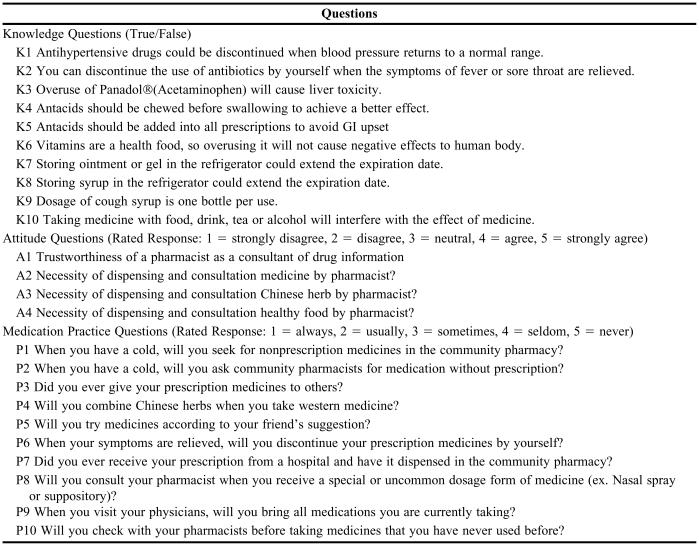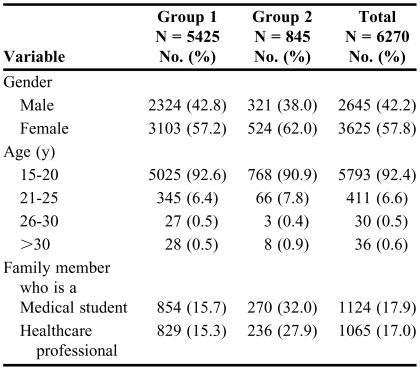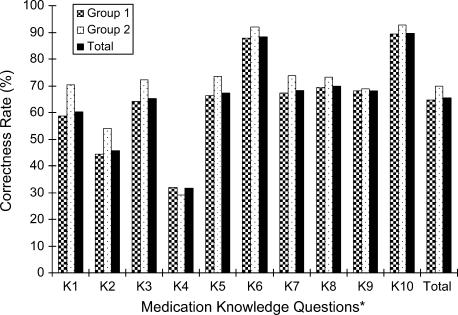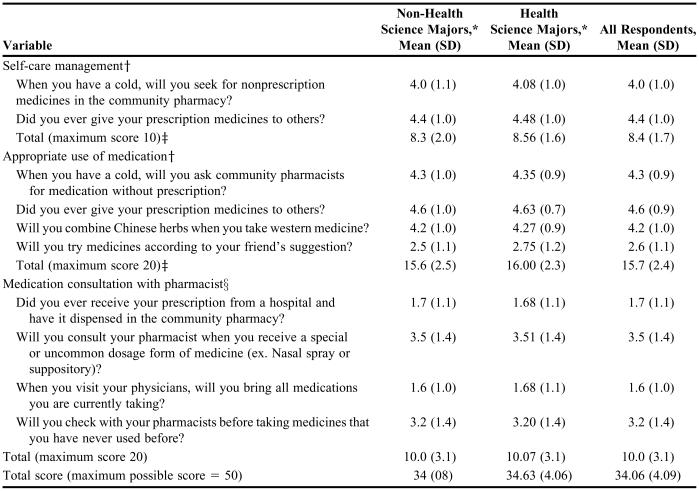Abstract
Objectives
To survey the knowledge, attitudes, and practices towards safe medication use of first-year college students in Taiwan.
Methods
One hundred forty-seven departments in 27 universities were sampled by stratified randomization. Three sections of the questionnaire were developed, including 10 true/false questions to measure knowledge, 4 questions for attitude in a 5-point scale, and 10 questions for practice in a 5-point scale.
Results
A total of 6270 subjects completed the survey instrument for a valid response rate of 91.9%. Students who were health science majors had safer medication practices than non-health science majors. However, students in both groups had low scores on appropriate antibiotics use, with a correctness rate of 45.8%. Knowledge relating to antacid use had the lowest number of correct responses among the 10 items included in the survey. Overall, the students showed positive attitudes toward (12.6 ± 2.2) and trusted (3.6 ± 0.7) pharmacists' consultation.
Conclusions
College students lack appropriate knowledge, attitudes, and practices related to the safe use of medications, and efforts are warranted in Taiwan.
Keywords: medication safety, knowledge, attitude, practice, pharmacist, students
INTRODUCTION
Medication use is undoubtedly a crucial issue in colleges and among young adults, including medical or non-medical use of prescription drugs, nonprescription drugs, and herbal products. The increased direct-to-consumer advertising of pharmaceutical products targets the young population, a generation exposed to large amounts of media directing them to self-medicate. The Centers for Disease Control and Prevention have identified that colleges and universities are important settings for delivering health promotion education and services to young adults.1 To successfully implement a rational safe-medication program, surveys of college students' knowledge, attitudes, and safe medication practices are essential for pharmacists and policymakers to design better strategies for preventing unsafe behaviors.
Both medical and non-medical use of prescription drugs among college students should be evaluated to prevent inappropriate behaviors. The Monitoring the Future (MTF) study found that the non-medical use of opioids by college students and young adults is now at its highest level in the past 2 decades.2-4 The global increase in the consumption of prescription drugs further documents the need for studying medication knowledge and behaviors. In 2000, 173 million people filled 2.2 billion outpatient prescriptions, accounting for $103 billion in expenditures and 7.9% of total health expenditures in the United States.5 In 2003, drug expenditures were about $27.92 billion and accounted for 24.6 % of total health expenditures reimbursed by the National Health Insurance Bureau of Taiwan.6,7 Inadequate knowledge of medication use may directly lead to overuse or patient noncompliance with a drug regimen, and result in serious outcomes. For example, early self-discontinuation of antibiotics, a common behavior in Taiwan, often leads to microbial resistance and/or treatment failure, such as multi-drug resistance tuberculosis (MDR-TB).8 Misunderstandings among college students about proper prescription drug use should be corrected to prevent negative outcomes.
The misuse of nonprescription drugs or herbal products has also become a serious problem in the young population, raising concerns of incorrect self-diagnosis, drug interaction, and use other than for the original indication. A survey on widely advertised medications indicated that the majority of college students used at least one of the advertised products, yet did not discuss this with their physicians.9 Less than half of female college students who used nonprescription medications for vaginal yeast infections, which can mask sexually transmitted diseases, reported using these products to their physicians.9 More than one third of college students took higher doses of nonprescription products than the products' labels recommended.10 As the annual sales of herbal products have increased from $1 billion in 1994 to $4 billion in 1998 in the United States, more effective patient education strategies are needed to prevent unwanted outcomes in the targeted population.11-12
The medication practices occurring in the young population reveals the complex relationships between health knowledge, attitudes, and behaviors, which must be considered in order to deliver effective health education. Medication consultation is a direct method of promoting safe use of medication. Its importance has been raised by the Ominbus Budget Reconciliation Act of 1990 (OBRA '90)13 However, one-way teaching is usually ineffective. Instead, promotion of patients' partnership and autonomy in their health care has been advocated by many professional associations, including the Institute for Safe Medication (ISMP), the American Society of Health System Pharmacists (ASHP), the National Patient Safety Foundation (NPSF), Agency for Healthcare Research and Quality (AHCP), and the National Council on Patient Information and Education (NCPIE).14-18 Two-way communication, with effective questioning by the health professional, provides opportunities to establish treatment goals and identify patient's drug safety-related problems.19,20
However, without first understanding college students' medication knowledge, attitudes, and practices, effective intervention cannot be designed. Thus, the objectives of this study were (1) to measure college students' knowledge of drug safety; (2) to evaluate students' attitudes toward medication consultation; (3) to assess self-care behaviors with regard to nonprescription medicines, medication consultation with pharmacists, and appropriate use of medicines among college students in Taiwan.
METHODS
A structured, self-administered questionnaire was designed by a group of faculty members and graduate students in the School of Pharmacy, Taipei Medical University. A separate panel including faculty members from the pharmacy school and experts in pharmacoeconomics or statistics evaluated the content for validity. In addition, 30 pharmacists examined the survey instrument for face validity. Thirty college students from diverse majors were invited to review the content of items, format, and wording to ensure the readability of the instrument for the first-year college students. The test-and-retest reliability was also determined using a Spearman correlation coefficient of 0.719.
The questionnaire was modified from one used in a previous survey of the general public and divided into 3 parts to assess students' knowledge of drug safety (Part 1), attitude toward medication consultation (Part 2), and medication use practices and consultation with pharmacists (Part 3).21 The survey instrument also requested demographic information, including gender, age, and whether the participant had family members currently enrolled in medical school or practicing as healthcare professionals.
Ten true/false questions were developed to evaluate the students' knowledge level of drug safety in the following areas: (1) anti-hypertensive drugs and regimens, (2) antibiotic use, (3) antacid use, (4) medication storage, and (5) vitamins, nonprescription drugs, and herbal product use. The details of each item were based on findings from a pilot research survey, which indicated lack of appropriate information about the above medications in Taiwan. Table 1 lists all items in the questionnaire.
Table 1.
Questions Included in a Survey of Safe Medication Practices of College Students in Taiwan
Four items were used to measure students' attitudes toward medications, Chinese herbs, and health food consultation by pharmacists (Table 2). All of the items in the attitude assessment were scored on a 5-point Likert scale, with 1 = strongly disagree, 2 = disagree, 3 = neutral, 4 = agree, and 5 = strongly agree. Higher scores represented more positive attitudes toward medication consultation provided by pharmacists.
Table 2.
Demographic Information of Participants
*Group 1 = non-health science majors; Group 2 = health science majors.
Statistical difference determined by chi-square test
The practice questionnaire included 10 items and was divided into 3 subscales: 2 items on self-care management, 4 items on appropriate use, and 4 items on prescription filling and medication consultation with a pharmacist (Table 3). All of the items in the practice questionnaire were scored on a 5-point Likert scale. For self-care management and appropriate use of medication dimensions, 1 = always, 2 = usually, 3 = sometimes, 4 = seldom, and 5 = never. The coding for medication consultation with a pharmacist was the reverse, with 1 = never, 2 = seldom, 3 = sometimes, 4 = usually, and 5 = always. A higher total score represents better practices associated with safer use of medications. An overall internal consistency reliability coefficient (Spearman's rho) was calculated for the questionnaire.
Table 3.
College Students' Attitudes Toward Medication Consultation (N = 6270)
*Non-health science majors = 5425 students; health science majors = 845 students
†Five point scale: 5 = strongly agree, 4 = agree, 3 = neither agree nor disagree (neutral response), 2 = disagree, 1 = strongly disagree
The study participants were sampled by stratified randomization to represent the population of 1489 departments in 139 universities in Taiwan. The sampling ratio was 10% by department. Each department was categorized for stratification depending on the classification in Taiwan's education system. The Departments were stratified into 3 categories according to disciplines. The first category included departments of literature, business, and law (872 departments); the second category included departments of science and engineering (383 departments); and the third category included health science-related departments (234 departments). Ten percent of the departments in each category were therefore randomized and sampled. After requesting permission from the sampled departments, the final sample included 83, 39, and 25 departments for category 1, 2, and 3, respectively, which accounts for 6917 students in 147 departments from 27 universities.
The drug safety survey of freshman students was conducted in randomly selected departments in Taiwan from September 2001 to December 2001. A full-time pharmacist was responsible for coordination of the survey and 8 part-time pharmacy students were trained to administer the survey instrument. The data collection process followed a standardized protocol, which included obtaining permission from the schools, as well as informing participants of the study's purpose and encryption of students' responses for confidentiality. After obtaining permission from the school, the interviewer was allowed to enter the classroom, deliver the questionnaire to students, give assistance to students, and collect the answer sheets after completion. These procedures guaranteed a high response rate.
Knowledge, attitude, and practice scores were analyzed by parametric statistics with a normal distribution for the datasets. The subgroup analysis utilized t tests to compare the differences between non-health science majors and health science majors. The ANOVA test was used to perform the comparison between multiple stratified groups. All statistical analyses were performed using the Statistical Package for the Social Science (SPSS 10.0, SPSS Inc, Chicago) computer software program. Statistical significance for all analyses was defined as a p value less than 0.05.
RESULTS
Of 6917 first-year college students from 147 departments in 27 universities surveyed from September 2001 to December 2001, 90.6 % (6270 students) completed and returned the questionnaire. Table 2 shows the demographic characteristics of the participants. Of the participants, 3625 (57.8%) were female and 2645 (42.2%) were male. The number of participants majoring in health science, including medicine, pharmacy, nursing, and other professionals, was 845 (13.2 %), and the number in non-health science majors was 5425 (86.8 %). There were 1124 (17.9%) participants with family members currently enrolled as medical students, and 1065 (17 %) with family members currently practicing as health care professionals.
The mean score on the knowledge portion of the questionnaire was 6.6 ± 2.3. The rates of correctness for all knowledge items were extremely diverse, ranging from 31.6% to 89.7% (Figure 1). Knowledge relating to antacid use had the lowest number of correct responses among the 10 items. Students in both groups also had low scores on appropriate antibiotics use, with a correctness rate of 45.8%.
Figure 1.
College students' responses to questions regarding knowledge of medication use. Group 1 = non-health science majors; Group 2 = health science majors. *K1-K10 refer to the knowledge questions included in the questionnaire and listed in Table 1.
Mean scores from group 1 and group 2 on the knowledge questionnaire were 6.5 ± 2.3 and 7.0 ±2.0, respectively, and were significantly different (p < 0.05). Health science majors gave a significantly higher number of correct responses than non-health science majors in 9 out of 10 areas including anti-hypertensive medication use, antibiotic use, indications for antacid use, and medication storage for ointments, gels, and syrups (p < 0.05).
Overall, the students showed positive attitudes toward (12.6 ± 2.2) and trusted (3.6 ± 1.0) pharmacists' consultation. There was no difference in responses between group 1 and group 2 on any questionnaire item concerning attitude. Further analysis of the health-science related group was performed to identify the level of trust felt toward the profession of pharmacy. A significant difference (p < 0.001) was identified between the scores of medical (3.5 ± 1.0), pharmacy (4.0 ± 1.0), and nursing students (3.7 ± 1.0).
The mean score on the questionnaire was 34.1 ± 4.1 out of a possible 50 points, indicating a need to improve the safety of college students' medication practices. The lowest score among the 3 dimensions was 10.04 ± 3.10 (4 items, maximum score 20) for the practice of medication consultation with pharmacists. The majority of participants (64.2%) never informed their doctor or pharmacist about medications currently being used. More than 60% of participants had their prescription dispensed at the hospital and never in a community pharmacy. A more serious unsafe practice was that 53.3% of participants usually discontinued their prescription medicines upon symptom relief without consulting their doctor or pharmacist. There was a significant difference in the total score and the scores of 2 specific dimensions of practice between group 1 and group 2 (p < 0.001). Health science majors did have safer practices than non-health science majors in self-care management and appropriate use of medication.
DISSCUSSION
The data demonstrate that college students in Taiwan have positive attitudes but still lack appropriate knowledge and safe practices in medication use. Knowledge and attitudes influence patients' behaviors and outcomes. Improvements in knowledge are often correlated with better health practices. The theory of reasoned action states that people intend to conduct a behavior, such as consult with pharmacists about medications, only when they evaluate it positively.22 Efforts to improve college students' knowledge of medication use are warranted to improve medication practices in Taiwan.
The present data strongly indicate that students' knowledge was less than satisfactory. With a maximum score of 10, the mean score was only 6.55 ± 2.25. Although students majoring in the health sciences demonstrated better scores, 45.8% of them thought it correct to discontinue antibiotics when the symptoms of fever or sore throat were relieved. The misunderstandings about antibiotics use were also found in a telephone survey, which showed that 27% of respondents with common cold believed that antibiotics made them recover more quickly, 32% believed that antibiotics prevented a more serious illness, and 48% expected their doctor to write a prescription for antibiotics.23 Among the health science students in the present study, 26.6% thought that antacids should be added to all prescriptions to avoid gastrointestinal upset. This misconception was reflected by the large percentage (52.2%) of prescription orders that included both antacids and other medications, thereby increasing the risk of drug interactions and creating an unnecessary economic burden.24 Educational efforts are needed to correct misguided knowledge and to improve student's medication practices.
All respondents in this study showed positive attitudes toward the necessity of medication consultation. The level of trust given to the pharmacist to provide drug information was also higher than the neutral point. Given the low level of knowledge concerning safe medication practice found among college students in Taiwan, the present study emphasizes the need for pharmacists to bridge the gap between what college students consider to be important and accurate information about medication. In an 18-item survey, more than 60% of respondents rated every item as important to know, but less than 50% of respondents received information concerning storage conditions, nonprescription or prescription drug interactions, what happens to the body if a dose is missed, and how to avoid side effects.25 Implementing strategies to educate patients to ask key questions as the AHCP advocated and to train pharmacists on how to ask effective questions will improve the two-way communication between pharmacists and patients in Taiwan.26
The data indicating inappropriate drug use practices further strengthens the need for medication education. In spite of positive attitudes toward consulting with pharmacists, the participants actually continued their incorrect medication practices. Drug interactions and duplications are inevitable since participants said they almost never informed their doctors and/or pharmacists about the medications they were taking. Consultation with the pharmacists before beginning a new medicine or new dosage was uncommon. These patterns indicate the urgent need to improve safe medication practices.
Many of the problems identified in this study could be improved by various methods. First, in an era of patient-centered medical and pharmaceutical care, patients must take more responsibility for proper medication use and identify key questions to ask their pharmacists. Pharmacists not only need to teach patients how to use medications safely, they also need to encourage patient autonomy by teaching them better communication skills. Policymakers should establish standard processes for managing nonprescription medications and dietary supplement products, as well as a budget for national patient education programs. A sophisticated strategy is needed to improve the knowledge, attitudes, and medication use practices among college students.
CONCLUSION
This study showed college students in Taiwan have positive attitudes toward medication consultation, but lack knowledge about proper use of medications and drug safety. Interventions to improve drug knowledge and safe medication practices, such as providing medication information, behavioral simulation, or even cognitive intervention, should be made immediately by pharmacists to improve the safety of medication use in Taiwan. Future study is needed to correct the behaviors and improve the medication knowledge of the people of Taiwan.
Table 4.
College Students' Practice Scores on Drug Safety Practices (N = 6270)
*Group 1 Non-health science majors = 5425 students; health science majors = 845 students
†Five point scale for self-care management and appropriate use of medication: 1 = always, 2 = usually, 3 = sometimes, 4 = seldom, 5 = never
‡Statistical difference between total score on self-caremanagement and total score on appropriate use of medication = P < 0.001
§Five point scale for medication consultation with pharmacist: 1 = never, 2 = seldom, 3 = sometimes, 4 = usually, 5 = always
REFERENCES
- 1.Centers for Disease Control and Prevention. Youth risk behavior surveillance: National College health risk behavior survey-United States. MMWR. 46(SS-6):1–54. [Google Scholar]
- 2.Johnston LD, O'Malley PM, Bachman JG. College students and adults ages 19-40. Vol. 2. Bethesda, MD: National Institute on Drug Abuse; Monitoring the future national survey results on drug use, 1975-2002. NIH publication 03-5376. [Google Scholar]
- 3.Johnston LD, O'Malley PM, Bachman JG. Secondary school students. Vol. 1. Bethesda, MD: National Institute on Drug Abuse; Monitoring the future national survey results on drug use, 1975-2002. NIH publication 03-5375. [Google Scholar]
- 4.McCabe SE, Teter CJ, Boyd CJ, et al. Nonmedical use of prescription opioids among U.S. college students: Prevalence and correlates from a national survey. Addic Behav. 2005;30:789–805. doi: 10.1016/j.addbeh.2004.08.024. [DOI] [PubMed] [Google Scholar]
- 5.Ray WA. Population-based studies of adverse drug effects. N Engl J Med. 2003;349:1592–4. doi: 10.1056/NEJMp038145. [DOI] [PubMed] [Google Scholar]
- 6.Huang WF, Chiang HC. Pharmaceutical benefit scheme and cost containment in Taiwan's National Health Insurance. J Pharm Finance Econ Policy. 2003;12:133–49. [Google Scholar]
- 7. The Bureau of National Health Insurance. Statistics of Annual Health Expenditure 1997-2003. Available at http://www.nhi.gov.tw. Accessed October 13, 2004.
- 8.Liaw YS, Hsueh PR, Yu CJ, et al. Drug resistance pattern of Mycobacterium tuberculosis in a university hospital in Taiwan, 1998-2002. J Formos Med Assoc. 2004;103(9):671–7. [PubMed] [Google Scholar]
- 9.Burak LJ, Damico A. College students' use of widely advertised medications. J Am Coll Health. 2000;49:118–21. doi: 10.1080/07448480009596293. [DOI] [PubMed] [Google Scholar]
- 10.Ellen PS, Bone PF, Stuart EW. How well do young people follow the label? An investigation of four classes of over-the –counter drugs. J Pub Policy Marketing. 1998;17:70–86. [Google Scholar]
- 11.Bent S, Ko R. Commonly used herbal medicines in the United States: a review. Am J Med. 2004;116:478–85. doi: 10.1016/j.amjmed.2003.10.036. [DOI] [PubMed] [Google Scholar]
- 12.Ng TP, Tan CH, Kua EH. The use of Chinese herbal medicines and their correlates in Chinese older adults: the Singapore Chinese Longitudinal Aging Study. Age Aging. 2004;33:135–42. doi: 10.1093/ageing/afh016. [DOI] [PubMed] [Google Scholar]
- 13.Scott DM, Wessels MJ. Impact of OBRA ‘90 on pharmacists’ patient counseling practices. J Am Pharm Assoc. 1997;37:401–6. doi: 10.1016/s1086-5802(16)30230-3. [DOI] [PubMed] [Google Scholar]
- 14.Barnett CW, Nykamp D, Ellington AM. Patient-guided counseling in the community pharmacy setting. J Am Pharm Assoc. 2000;40:765–72. doi: 10.1016/s1086-5802(16)31123-8. [DOI] [PubMed] [Google Scholar]
- 15.Vogt EM. Effective Communication of Drug Safety Information to Patients and the Public: A New Look. Drug Safety. 2002;25:313–21. doi: 10.2165/00002018-200225050-00002. [DOI] [PubMed] [Google Scholar]
- 16. Institute for Safe Medication (ISMP). How to take your medication safely. Available at http://www.ismp.org. Accessed September 12, 2002.
- 17. American Society of Health-system Pharmacists. Pharmacist's Guide to Your Medications. Available at http://www.aha.org/medicationsafety. Accessed Septemeber 12, 2002.
- 18. The National Patient Safety Foundation (NPSF) Workshop. Available at http://www.npsf.org/download/rx_safe_use_exec_summary.pdf. Accessed September 12, 2002.
- 19. Agency for Healthcare Research and Quality (AHCP). Twenty Tips for Patients. Available at http://www.ahcpr.gov/consumer. Accessed September 12, 2002.
- 20. National Council on Patient Information and Education (NCPIE). Available at http://www.talkaboutrx.org. Accessed September 12, 2002.
- 21.Chen HY, Hsiao FY, Lin YC, Chiang YC, Liu MH. Evaluation of drug safety-related knowledge, attitudes, and behaviors among general public in Taiwan. Presented in the 2003 Congress of International Pharmaceutical Federation. [Google Scholar]
- 22.Ajzen I, Fishbein M. Attitude-behavior relations: a theoretical analysis and review of empirical research. Psych Bull. 1977;84:888–918. [Google Scholar]
- 23.Vanden Eng J, Marcus R, Hadler JL, et al. Consumer attitudes and use of antibiotics. Emerg Infect Dis. 2003;9:1128–35. doi: 10.3201/eid0909.020591. [DOI] [PMC free article] [PubMed] [Google Scholar]
- 24.Chen TJ, Chou LF, Hwang SJ. Application of a data-mining technique to analyze coprescription patterns for antacids in Taiwan. Clin Ther. 2003;25:2453–63. doi: 10.1016/s0149-2918(03)80287-4. [DOI] [PubMed] [Google Scholar]
- 25.Rutter PM, Horsley E, Brown DT. Evaluation of community pharmacists' recommendations to standardized patient scenarios. Ann Pharmacother. 2004;38:1080–5. doi: 10.1345/aph.1D519. [DOI] [PubMed] [Google Scholar]
- 26.Marja A, Riitta A. The “questions to ask about your medicines” campaign. Med Care. 1998;36:422–7. doi: 10.1097/00005650-199803000-00017. [DOI] [PubMed] [Google Scholar]







